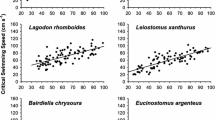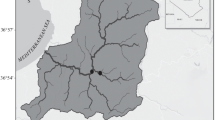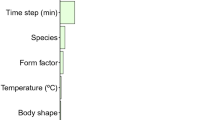Abstract
Rivers are dynamic systems where flow is constantly changing, making early fish life stages with lower swimming abilities potentially vulnerable to rapid changes in water velocity. In this study, we evaluated the response of critical young life stages of three Iberian leuciscids – Achondrostoma occidentale, Iberochondrostoma lusitanicum, and Iberochondrostoma almacai – to increasing water velocities, by determining their critical swimming speed (Ucrit) and its relation with morphometric traits potentially associated with better swimmers. Results suggest a positive relation between both fish length and body depth with Ucrit and species-specific differences in swimming performance. Moreover, most fish could not withstand the maximum velocity tested (20 cm s−1), which can be surpassed in the rivers they occur. This study highlights the importance of considering individual traits for future management of fish stocks in rivers.


Similar content being viewed by others
References
Adams SR, Hoover JJ, Killgore KJ (2009) Swimming performance of the Topeka shiner (Notropis topeka) an endangered Midwestern minnow. Am Midl Nat 144:178–186. https://doi.org/10.1674/0003-0031(2000)144[0178:SPOTTS]2.0.CO;2
Alexandre CM, Quintella BR, Ferreira AF, Romão FA, Almeida PR (2013) Swimming performance and ecomorphology of the Iberian barbell Luciobarbus bocagei (Steindachner, 1864) on permanent and temporary rivers. Ecol Freshw Fish 23(2):244–258. https://doi.org/10.1111/eff.12073
Alexandre C, Branca R, Quintella B, Almeida PR (2016) Critical swimming speed of the southern straight-mouth nase Pseudochondrostoma willkommii (Steindachner, 1866), a potamodromous cyprinid from southern Europe. Limnetica 35(2):365–372. https://doi.org/10.23818/limn.35.29
Bainbridge R (1960) Speed and stamina in three fish. J Exp Biol 37:129–153
Beamish FWH (1978) Swimming capacity. Volume 7. In: Hoar WS, Randall DJ (eds) fish physiology. academic press, New York, pp 101–187
Bestgen KR, Mefford B, Bundy JM, Walford CD, Compton RI (2010) Swimming performance and fishway model passage success of Rio Grande silvery minnow. Trans Am Fish Soc 5(2):433–448. https://doi.org/10.1577/t09-085.1
Boavida I, Santos JM, Pinheiro NA, Ferreira MT (2013) Fish-habitat response to hydropeaking. In: Proceedings of the 35th IAHR world congress, 8–13 September, Chengdu, China
Brett JR (1964) The respiratory metabolism and swimming performance of young sockeye salmon. J Fish Res Board Can 21:1183–1226
Brett JR (1965) The relation of size to rate of oxygen consumption and sustained swimming speed of sockeye salmon (Oncorhynchus nerka). J Fish Res Board Can 23:1491–1501
Burnham K, Anderson D (2002) Model selection and multimodel inference, 2nd edn. Springer, New York
Cai L, Hou Y, Katopodis C, He D, Johnson D, Zhang P (2019) Rheotaxis and swimming performance of perch-barbel (Percocypris pingi, Tchang, 1930) and application to design of fishway entrances. Ecol Eng 132:102–108. https://doi.org/10.1016/j.ecoleng.2019.04.009
Deslauriers D, Kieffer JD (2012) The effects of temperature on swimming performance of juvenile shortnose sturgeon (Acipenser brevirostrum). J Appl Ichthyol 28(2):176–181. https://doi.org/10.1111/j.1439-0426.2012.01932.x
Drucker EG (1996) The use of gait transition speed in comparative studies of fish locomotion. Am Zool 36:555–566
Dudgeon D, Arthington AH, Gessner MO, Kawabata Z-I, Knowler DJ, Lévêque C, Naiman RJ, Prieur-Richard AH, Soto D, Stiassny ML, Sullivan CA (2006) Freshwater biodiversity: importance, threats, status and conservation challenges. Biol Rev 81(2):163–182. https://doi.org/10.1017/s1464793105006950
Faria A, Ojanguren A, Fuiman L, Gonçalves E (2009) Ontogeny of critical swimming speed of wild-caught and laboratory-reared red drum Sciaenops ocellatus larvae. Mar Ecol Prog Ser 384:221–230
Faria AM, Borges R, Gonçalves EJ (2014) Critical swimming speeds of wild-caught sand smelt Atherina presbyter larvae. J Fish Biol 85(3):953–959. https://doi.org/10.1111/jfb.12456
Fisher R, Leis JM (2009) Swimming speeds in larval fishes: from escaping predators to the potential for long distance migration. Pp. 333-373. In: Fish locomotion: an eco- ethological perspective (Ed. CRC press and Paolo Domenici). United States of America
George AE, Garcia T, Stahlschmidt BH, Chapman DC (2018) Ontogenetic changes in swimming speed of silver carp, bighead carp, and grass carp larvae: implications for larval dispersal. PeerJ 6:e5869. https://doi.org/10.7717/peerj.5869
Gil F, Sousa-Santos C, Almada V (2010) A simple and inexpensive technique for the Ex Situ reproduction of critically endangered cyprinids Achondrostoma occidentale as a case study, Journal of the world aquaculture Society. 41(4):661–664. https://doi.org/10.1111/j.1749-7345.2010.00408.x
Haas TC, Heins DC, Blum MJ (2015) Predictors of body shape among populations of a stream fish (Cyprinella venusta, Cypriniformes: Cyprinidae). Biol J Linn Soc 115(4):842–858. https://doi.org/10.1111/bij.12539
Hammer C (1995) Fatigue and exercise tests with fish. Comparative biochemistry and physiology part a. Physiology 112(1):1–20
IUCN (2019). The IUCN red list of threatened species. Version 2018-2. ISSN 2307-8235. URL: http://www.iucnredlist.org. Accessed on 28 January 2019
Katopodis C, Cai L, Johnson D (2019) Sturgeon survival: the role of swimming performance and fish passage research. Fish Res 212:162–171. https://doi.org/10.1016/j.fishres.2018.12.027
Lechner A, Keckeis H, Humphries P (2016) Patterns and processes in the drift of early developmental stages of fish in rivers: a review. Rev Fish Biol Fish 26(3):471–489. https://doi.org/10.1007/s11160-016-9437-y
Magalhães MF, Schlosser IJ, Collares-Pereira MJ (2003) The role of life history in the relationship between population dynamics and environmental variability in two Mediterranean stream fishes. J Fish Biol 63(2):300–317. https://doi.org/10.1046/j.1095-8649.2003.00148.x
Mameri D, Sousa-Santos C, Robalo JI, Magalhães MF (2018) Growth and age structure in captive and wild stocks of the endangered western ruivaco Achondrostoma occidentale (Cyprinidae). Limnetica 37(1):105–115. https://doi.org/10.23818/limn.37.09
Mateus CS, Quintella BR, Almeida PR (2008) The critical swimming speed of Iberian barbel Barbus bocagei in relation to size and sex. J Fish Biol 73(7):1783–1789. https://doi.org/10.1111/j.1095-8649.2008.02023.x
Milly PCD, Wetherald RT, Dunne KA, Delworth TL (2002) Increasing risk of great floods in a changing climate. Nature 415:514–517. https://doi.org/10.1038/415514a
Myers N, Mittermeier RA, Mittermeier CG, da Fonseca GAB, Kent J (2000) Biodiversity hotspots for conservation priorities. Nature 403:853–858. https://doi.org/10.1038/35002501
Peake SJ (2008) Swimming performance and behaviour of fish species endemic to Newfoundland and Labrador: a literature review for the purpose of establishing design and water velocity criteria for fishways and culverts. Canadian manuscript report of fisheries and aquatic sciences 2843:v + 52p
Pires A, Magalhães MF, Moreira da Costa L, Alves MJ, Coelho MM (2008) Effects of an extreme flash flood on the native fish assemblages across a Mediterranean catchment. Fish Manag Ecol 15(1):49–58. https://doi.org/10.1111/j.1365-2400.2007.00570.x
Plaut I (2001) Critical swimming speed: its ecological relevance. Comp Biochem Physiol A Mol Integr Physiol 131(1):41–50. https://doi.org/10.1016/S1095-6433(01)00462-7
R Core Team (2018). R: A language and environment for statistical computing. R Foundation for Statistical Computing, Vienna, Austria. URL:https://www.R-project.org/
Romão F, Quintella BR, Pereira TJ, Almeida PR (2012) Swimming performance of two Iberian cyprinids: the Tagus nase Pseudochondrostoma polylepis (Steindachner, 1864) and the bordello Squalius carolitertii (Doadrio, 1988). J Appl Ichthyol 28(1):26–30. https://doi.org/10.1111/j.1439-0426.2011.01882.x
Santos JM, Ferreira MT (2008) Microhabitat use by endangered Iberian cyprinids nase Iberochondrostoma almacai and chub Squalius aradensis. Aquatic Sciences 70(3):272–281
Schmutz S, Jurajda P, Kaufmann S, Lorenz AW, Muhar S, Paillex A, Poppe M, Wolter C (2016) Response of fish assemblages to hydromorphological restoration in central and northern European rivers. Hydrobiologia 769(1):67–78. https://doi.org/10.1007/s10750-015-2354-6
Schönhuth S, Vukić J, Šanda R, Yang L, Mayden RL (2018) Phylogenetic relationships and classification of the Holarctic family Leuciscidae (Cypriniformes: Cyprinoidei). Mol Phylogenet Evol 127:781–799. https://doi.org/10.1016/j.ympev.2018.06.026
Silva AT, Santos JM, Ferreira MT, Pinheiro AN, Katopodis C (2011) Effects of water velocity and turbulence on the behaviour of Iberian barbel (Luciobarbus bocagei, Steindachner 1864) in an experimental pool-type fishway. River Res Appl 27(3):360–373. https://doi.org/10.1002/rra.1363
Silva SSR (2016) Variabilidade espacial e temporal da capacidade natatória de um ciprinídeo ibérico, o ruivaco, Achondrostomaoligolepis (Robalo, Doadrio, Almada & Kottelat, 2005). Universidade de Évora, MSc thesis Retrieved from: http://hdl.handle.net/10174/21807 [In Portuguese]
Sousa-Santos C, Gil F, Almada VC (2014a) Ex situ reproduction of Portuguese endangered cyprinids in the context of their conservation. Ichthyol Res 61(2):193–198. https://doi.org/10.1007/s10228-013-0383-6
Sousa-Santos C, Robalo J, Almada V (2014b) Spawning behaviour of a threatened Iberian cyprinid and its implications for conservation. Acta ethologica 17(2):99–106. https://doi.org/10.1007/s10211-014-0185-5
Tudorache C, Viaenen P, Blust R, de Boeck G (2007) Longer flumes increase critical swimming speeds by increasing burst-glide swimming duration in carp Cyprinus carpio, L. J Fish Biol 71(6):1630–1638. https://doi.org/10.1111/j.1095-8649.2007.01620.x
Verhille CE, Poletto JB, Cocherell DE, DeCourten B, Baird S, Cech JJ, Fangue NA (2014) Larval green and white sturgeon swimming performance in relation to water-diversion flows. Conservation Physiology 2(1):cou031–cou031
Vernables WN, Ripley BD (2002) Modern applied statistics with S, Fourth edn. Springer, New York
Vörösmarty CJ, McIntyre PB, Gessner MO, Dudgeon D, Prusevich A, Green P, Glidden S, Bunn SE, Sullivan CA, Liermann CR, Davies PM (2010) Global threats to human water security and river biodiversity. Nature 467(7315):555–561. https://doi.org/10.1038/nature09440
Acknowledgements
We would like to thank Aquário Vasco da Gama for allowing the study to be conducted in their facilities using the captive fish stocks. A special thanks to José Pedro for helping setting the experimental facility and also to Filipe Romão and Paulo Branco for readily providing their paper on critical swimming speed.
Funding
This study was funded by FCT - Fundação para a Ciência e a Tecnologia (partially FEDER funded) through MARE (UID/MAR/04292/2019) (MARE/ISPA-IU). Daniel Mameri is currently supported by a PhD grant (PD/BD/142885/2018) from the FLUVIO Program – River Restoration and Management, sponsored by FCT.
Author information
Authors and Affiliations
Corresponding author
Ethics declarations
Conflict of interest
The authors declare that they have no conflicts of interest.
Human and animal rights and informed consent
This study was performed in accordance with the European directive 2010/63/UE for the protection of animals used for scientific purposes and undertaken under the supervision of an accredited expert in laboratory animal science (following FELASA category C recommendations). The experiments were approved by ISPA’s Animal Welfare Body (Permit Number 01/2019) and all methods were performed in accordance with the relevant guidelines and regulations.
Additional information
Publisher’s note
Springer Nature remains neutral with regard to jurisdictional claims in published maps and institutional affiliations.
Electronic supplementary material
ESM 1
(DOCX 16 kb)
Rights and permissions
About this article
Cite this article
Mameri, D., Sousa-Santos, C., Robalo, J.I. et al. Swimming performance in early life stages of three threatened Iberian Leuciscidae. acta ethol 23, 23–29 (2020). https://doi.org/10.1007/s10211-019-00331-9
Received:
Revised:
Accepted:
Published:
Issue Date:
DOI: https://doi.org/10.1007/s10211-019-00331-9




